Clipart tagged: ‘gravity’
Gravitational Attraction
"Two cannon balls, when suspened by long cords, so as to hang quite near each other, are found to exert…

Balancer Toy Illustration
The stability of the "balancer" depends on the fact that, owing to the weight of the two leaden balls,…

Center of Gravity
"Why does a person carrying a weight upon his back stoop forward? In order to bring the center of gravity…

Center of Gravity
"Why does a person carrying a weight upon his back stoop forward? In order to bring the center of gravity…
Center of Gravity
"The center of gravity, in any body or system of bodies is that point upon which the body, or system…

Center of Gravity
"But if one of the balls be heavier than the other, then the centre of gravity will, in proportion,…

Center of Gravity
"In a body of equal thickness, as a board, or a slab of marble, but otherwise of an irregular shape,…

Center of Gravity
"If w and W, fig. 3, be two bodies of known weight, their center of gravity will be at C." —Hallock…
!["The part of the body in which the centre of gravity is situated, may be found, in some cases, by balancing it on a point. Thus the centre of gravity of the poker represented [here] lies directly over the point on which it is balanced." —Quackenbos 1859](https://etc.usf.edu/clipart/36300/36326/centergrav_36326_mth.gif)
Center of Gravity
"The part of the body in which the centre of gravity is situated, may be found, in some cases, by balancing…

Center of Gravity
"When such a surface is irregular in shape, suspend it at any point, so that it may move freely, and…

Center of Gravity of Standing Blocks
"Where five blocks are placed in this position, the point of gravity is near the centre of the thrd…

Compound Center of Gravity
"Find the center of gravity of two of the bodies, as W1, and W4, in fig 4. Assume that the weight of…
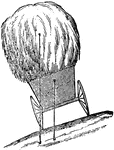
Center of Gravity of a Load of Hay
"A load of hay...upsets where one wheel rises by little above the other, because it is broader on the…
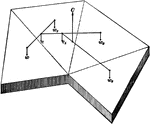
Center of Gravity of an Irregular Plane
"To find the center of gravity of any irregular plane figure, but of uniform thickness throughout, divide…
!["When a line of direction falls within the base, a body stands when not, it falls... On the same principle, a load of stone may pass safely over a hillside, on which a load of hay would be overturned [as shown by the line of direction in this illustration]." —Quackenbos 1859](https://etc.usf.edu/clipart/36300/36329/lod_cog_36329_mth.gif)
Line of Direction from the Center of Gravity of an Object
"When a line of direction falls within the base, a body stands when not, it falls... On the same principle,…
!["When two bodies of equal weight are connected by a rod, the centre of gravity will lie in the middle of that rod. When two bodies of unequal weight are so connected, the centre of gravity will be nearer to the heavier one. These principles are illustrated [here], in which C represents the centre of gravity." —Quackenbos 1859](https://etc.usf.edu/clipart/36300/36328/cog_rod_36328_mth.gif)
Center of Gravity of Rod with Weights
"When two bodies of equal weight are connected by a rod, the centre of gravity will lie in the middle…

Center of Gravity of a Rolling Ball
"When a ball is rolling on a horizontal plane, the centre of gravity is not raised, but moves in a straight…
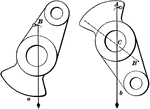
Center of Gravity of a Solid
"In a body free to move, the center of gravity will lie in a vertical plumb-line drawn through the point…

Daniel Cell
"Daniel gravity cell, 'crowfoot' pattern. this is a two fluid cell in which gravity instead of a prous…
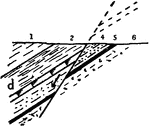
Gravity Fault
A fault is a planar fracture in rock in which the rock on one side of the fracture has moved with respect…

Gravity Fault
A fault is a planar fracture in rock in which the rock on one side of the fracture has moved with respect…

Gravity Fault
A fault is a planar fracture in rock in which the rock on one side of the fracture has moved with respect…

Gravity Fault
A fault is a planar fracture in rock in which the rock on one side of the fracture has moved with respect…

Gravity Fault
A fault is a planar fracture in rock in which the rock on one side of the fracture has moved with respect…
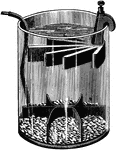
Gravity Cell
"The electric resistance of the porous cup employed in the Daniel cell, and the local action produced…

Gravity Train Remontoire
"E represents the scape-wheel turning in a minute, and e its pinion, which is driven by the wheel D…
Gravity Proved by Cannon Balls
"That the cannon ball is capable of attracting as well as being attracted, may be proved by suspending…

Guillotine
(1.) The guillotine is an instrument employed for the purpose of decapitation. It was officially introduced…
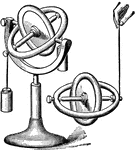
Gyroscope
"The Gyroscope is an instrument constructed by M. Foucault to make the rotation of the earth visible.…
Increased Velocity
"The principle of increased velocity as bodies descend from a height, is curiously illustrated by pouring…

Knight's Experiment
"Knight's experiment, substituting centrifugal "force" for gravity" proved that stems do not grow upwards…
Lactometer
"Galactometer. A species of hydrometer for determining the richness of milk by its specific gravity."…

Isaac Newton Discovering Gravity
An illustration of Sir Isaac Newton sitting on the ground being hit by an apple falling out of a tree…

Death Mask of Sir Isaac Newton
The death mask of Sir Isaac Newton, who discovered the law of gravitation.

Sir Isaac Newton
(1642-1727) English natural philosopher, mathematician, and physicist most famous for gravity and his…
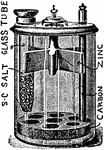
Partz Cell
"Partz acid gravity cell. In this form of cell, the electrolyte which surrounds the zinc is either magnesium…
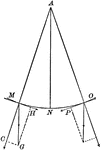
Motion of a Pendulum
"When the pendulum is drawn from its vertical position, the force of gravity, MG, is resolved into two…
!["[This illustration] shows the path of a stone thrown obliquely from the hand. The propelling force sends it in a straight line to A, and would take it on in the same direction to B, were it not that, as soon as its velocity becomes sufficiently diminished, gravity and the air's resistance give it a circular motion to C, and finally bring it to the earth at D." —Quackenbos 1859](https://etc.usf.edu/clipart/36300/36322/proj_mot_36322_mth.gif)
Projectile Motion of a Stone
"[This illustration] shows the path of a stone thrown obliquely from the hand. The propelling force…

Separator
"A glass vessel used to separate liquids which differ in specific gravity and are not miscible." -Whitney,…

Specific Gravity of Solids
One of the commonest ways of determining the density of a solid body is to weight it first in air and…
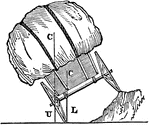
Vehicle on hill
"A loaded vehicle is represented as crossing the side of a hill, which has been raised one wheel above…
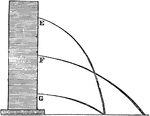
Water Velocity and Gravity
"If a vessel be filled with water, and three apertures be made in its sie at E F G, the fluid will be…

